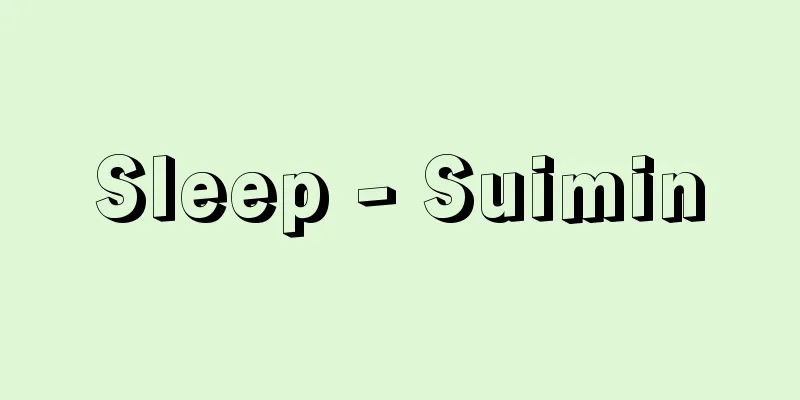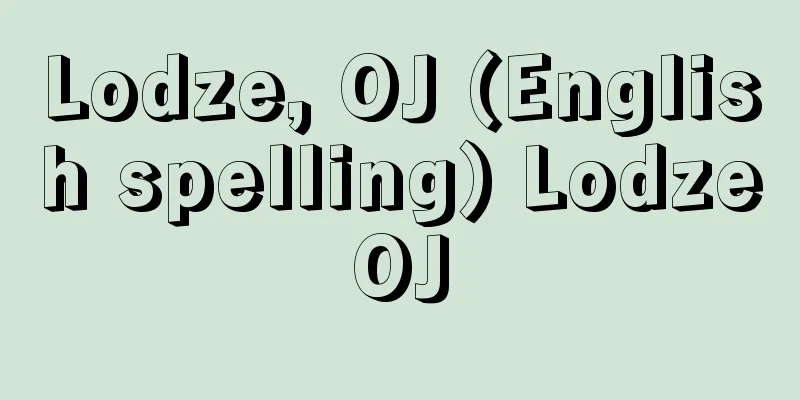Sleep - Suimin

|
Generally speaking, it is a periodic, physiological state of loss of consciousness, but it is difficult to define it completely. In the case of sleep, the individual appears to be unresponsive to changes in the environment, and their senses and reflexes are impaired, but they can be awakened and they adopt a specific sleeping posture. These characteristics distinguish sleep from pathological states of unconsciousness such as coma and anesthesia. Electroencephalograms are always used in scientific sleep research. Let's take a look at typical changes in electroencephalograms during sleep in a healthy adult. When awake and with eyes closed, alpha waves (α waves) of around 10 Hz are seen (wakefulness stage), but as you begin to doze off, the alpha waves disappear and small amplitude slow waves of 4 to 6 Hz appear (stage 1 sleep). Next, large amplitude sharp waves called K complexes and spindle waves of about 14 Hz appear (stage 2 sleep). As the sleep progresses, in addition to spindle waves, large amplitude slow waves of about 3 Hz appear (stage 3 sleep), and ultimately only large slow waves of 1 to 3 Hz remain (stage 4 sleep). In this way, it can be said that the frequency of brain waves generally slows down as sleep deepens. [Torii Shizuo] Two types of sleepWhen we think of sleep as a night's sleep, it was once thought that we went from wakefulness to deep sleep (stage 4) and then back to wakefulness, but it is now known that we go through several stages. That is, sleep is cyclical, and after going from wakefulness to stages 1, 2, 3, and 4, there are four or five periods when we return to a state similar to stage 1. This stage is considered to be a different state from the other stages of sleep because it is a stage in which rapid eye movement (abbreviated as REM) is present and skeletal muscle tone is lost. The stage with rapid eye movement is called REM sleep, and the remaining stages of sleep are called non-REM sleep because they do not have rapid eye movement. In addition, stages 3 and 4 of non-REM sleep are characterized by large slow waves, so they are collectively called slow-wave sleep. In the case of animals, although their brain waves show the pattern of the wakefulness stage, they are difficult to wake up even when sensory stimuli are applied, and they may show a state that seems to be deep sleep behaviorally. Since the relationship between the brain wave image and the depth of sleep does not match the conventional pattern, it is called paradoxical sleep. Normal animal sleep is also often called slow-wave sleep because it is dominated by slow waves. For this reason, slow-wave sleep in animals corresponds to non-REM sleep in humans. [Torii Shizuo] The phylogeny of sleepAccording to the behavioral definition of sleep, most vertebrates have some form of sleep. Fish and amphibians have periods of quiescence and elevated arousal threshold (the minimum level of stimulation required to wake them up), but their EEGs remain almost unchanged. Reptiles exhibit behavioral sleep, and show slow waves in their EEGs. They may also experience brief periods of sleep that are very similar to REM sleep. Birds clearly show both non-REM and REM sleep, but REM sleep is very short, accounting for only 1-5% of their total sleep time. Mammals have clear non-REM and REM sleep. However, it has been reported that echidnas, a primitive mammal, do not have REM sleep. In mammals, carnivores generally tend to have more REM sleep than herbivores. Omnivores are somewhere in between. This is thought to be because herbivores are in a very dangerous situation during REM sleep, as their muscles are completely relaxed during this period. [Torii Shizuo] The ontogeny of sleepNewborns sleep for 16-18 hours, half of which is in REM sleep. Adults generally spend 16-17 hours awake and 7-8 hours asleep. Of this sleep time, 6 hours are in NREM sleep and 1-2 hours in REM sleep. Both NREM and REM sleep decrease slightly with age. Also, sleep cycles (from the end or onset of one REM period to the end or onset of the next REM period) are clearly present from birth. In newborns, the cycle is 50-60 minutes long, but as children develop, it gradually lengthens to about 90 minutes. A 24-hour sleep-wake cycle is then superimposed on this sleep cycle, resulting in the adult pattern of one sleep period usually occurring every 24 hours. [Torii Shizuo] Physiological functions during sleepDuring sleep, various physiological changes occur that differ from those that occur when the person is awake and engaged in various activities. These are described in detail below. (1) Heart rate: Your heart rate decreases when you are just lying down quietly, and it tends to decrease gradually throughout the night's sleep. However, it increases significantly during REM sleep. (2) Blood Pressure During the course of a night's sleep, blood pressure tends to drop in the first half of the night and gradually rise in the second half. As expected, blood pressure also rises in line with REM sleep. (3) Breathing: The overall tendency for breathing rate to decrease during sleep is that it remains relatively stable compared to changes in heart rate and blood pressure. However, during REM sleep, breathing rhythm becomes irregular. (4) Penile erection: This occurs in conjunction with REM sleep. Since REM sleep is more prevalent in the morning, this explains the phenomenon of early morning erections. Also, the presence or absence of early morning erections can be used to determine whether or not REM sleep occurred. (5) Body temperature: Body temperature is lowest at around 4 a.m., but gradually rises thereafter until you wake up. Body temperature is not significantly affected by REM sleep, but there is a relationship in which REM sleep occurs more when body temperature is low. Body temperature follows a 24-hour cycle, and even if you live a life in which the day and night are reversed, the rhythm of your body temperature does not change easily. The so-called jet lag that occurs when traveling abroad occurs because body temperature is lowest during daytime activities. It takes an average of four days for body temperature to adapt to such a reversed lifestyle. (6) Body Movement We turn over in our sleep about 30 times during the night. Of these, the most frequent movements are during stage 1 sleep and before and after REM sleep, and the least frequent movements are during stages 3 and 4 (slow wave sleep). Too much or too little body movement is not considered good sleep. (7) Sweating Sweating increases soon after falling asleep, but decreases as sleep progresses. It is especially suppressed during REM sleep. [Torii Shizuo] Sleep PhenomenaWhat has been described so far is a physiological function common to most people, however, during sleep, various phenomena are exhibited depending on the individual, as described below. (1) Sleep talking: This is mainly seen in the second and third stages of sleep, but not necessarily limited to these times. However, sleep talking is less common during REM sleep. This is because the muscles around the mouth lose tension during REM sleep, making it difficult to speak clearly. (2) Sleepwalking: A person suddenly gets up and sits on the floor while sleeping, or in severe cases, starts walking. This is common in children, but can also be seen in the elderly. In children, it occurs during the third or fourth stage of sleep. In the elderly, it can occur when muscle tension does not disappear even during REM sleep. (3) Night terrors: A person wakes up suddenly, screaming and acting anxious or frightened while sleeping. This occurs during the fourth stage of sleep. (4) Nocturnal enuresis: Children are able to control their urination at will from about the age of three, but nocturnal enuresis refers to cases where a child still leaks urine at night even after this age. Nocturnal enuresis is seen in approximately 10% of children aged four or five. It most often occurs in the first third of nighttime sleep, and more often than not begins during deep sleep in the third or fourth stages of sleep. Since children spend a lot of time in deep sleep, it can be said that there are conditions that make nocturnal enuresis more likely to occur. (5) Nightmares These mainly occur during REM sleep and refer to a state in which one wakes up from a frightening dream. When one wakes up, one can recall the details of the frightening dream. Nightmares are not accompanied by the sense of fear or increased pulse rate that night terrors are, and when one wakes up, one can immediately adapt to their surroundings. Nightmares are seen in people of all ages, and are more likely to occur when one is anxious, worried, or stressed. Although the frequency varies from person to person, neurotic people are generally more likely to have nightmares. (6) Teeth grinding: This occurs in 5-15% of normal people, but is relatively common in children and adolescents. It is a phenomenon in which the upper and lower jaws are ground together during sleep due to activity of the masseter muscles, but the person does not wake up or notice that they are grinding their teeth. It can occur during any sleep stage, but is most common in stages 1 and 2. (7) Head shaking: Rhythmic head shaking from side to side, often seen when falling asleep. It is more common in children and less common after puberty. It is a habit similar to thumb sucking, and may be caused by stress. (8) Sleep paralysis: A condition in which a person is unable to move his/her limbs or speak when falling asleep or waking up in the morning. Sometimes, he/she is unable to even open his/her eyes. When experiencing sleep paralysis, the person knows what state he/she is in and can recall it later. It may also be accompanied by vivid or frightening hallucinations. It generally ends suddenly when the person makes an effort to get out of it or when someone speaks to him/her. Sleep paralysis is a type of REM sleep, and is thought to be a state in which the person is awake but has relaxed muscles and continues to experience dreams. (9) Migraine: A headache that wakes you up. It tends to occur during REM sleep. Also, when you wake up in the morning, you remember the experience of having a migraine. It does not occur before puberty. It is thought that migraines are caused by blood pressure fluctuations that occur during REM sleep. (10) Angina pectoris People with abnormalities in the coronary arteries of the heart often suffer from attacks of transient tightness or pain in the chest in the middle of the night. This is angina pectoris, and the majority of attacks occur during REM sleep. When an attack occurs, the heart rate increases soon after entering REM sleep, changes are observed on the electrocardiogram, and the person wakes up after a few minutes feeling short of breath. As a preventative measure, it is possible to suppress REM sleep with sleeping pills. (11) Stomach pain If you have a duodenal ulcer, you may experience pain or discomfort in your solar plexus during the night. Stomach pain also occurs during REM sleep. This is because, while normal people experience a decrease in gastric juice secretion during sleep, people with this disease experience an increase in gastric juice secretion during the night. (12) Bronchial asthma Asthma patients often suffer from attacks in the middle of the night. In adult asthma, no association has been found with a specific sleep stage, but in children, asthma attacks occur frequently in the latter half of the night. However, attacks do not necessarily coincide with REM sleep. In addition, attacks do not occur in stages 3 and 4 of sleep. (13) Snoring Snoring occurs when the upper airway narrows during sleep, causing turbulence in the respiratory airflow. Causes of the narrowing of the upper airway include the accumulation of nasal mucus and other secretions, hypertrophic rhinitis, abnormalities of the soft palate, enlarged tonsils, a sunken tongue, and obesity. As a countermeasure, it is recommended to receive treatment if there is an ENT cause. Also, since snoring is related to sleeping position, snorers should sleep on their side. (14) Sleep apnea syndrome This is a disease in which breathing stops five or more times during sleep. It is accompanied by snoring, daytime sleepiness, and headaches upon waking. Many patients with this disease also have lifestyle-related diseases such as high blood pressure, heart disease, stroke, and diabetes. If apnea is left untreated, it can be life-threatening. If this disease is suspected, it is important to examine the patient's sleep state at night. In order to simultaneously measure the patient's sleep and breathing state, overnight polygraphy is essential. Electroencephalograms, electrocardiograms, chest movements, and nasal airflow are continuously measured. The cause is obstruction of the upper airway due to factors such as fat deposits around the neck, enlarged tonsils, adenoids, a large tongue, or a small jaw. However, as it is closely related to lifestyle habits, the first step in treatment is to reassess your lifestyle. Obese people should try to exercise, such as by taking a walk every day. Smoking and sleeping pills are not good as they make apnea worse. Also, reducing evening drinks can help alleviate apnea. Another method to prevent airway obstruction is to sleep wearing a mask called a cPAP (contrast prostatic hypertension). This is a device that delivers air by applying positive pressure. [Torii Shizuo] Sleep and DreamsDuring sleep, various changes occur not only in physical functions but also in mental functions. In general, the ability to perceive and learn declines after falling asleep, so so-called sleep learning (a method of activating the cerebrum through auditory stimulation during sleep to allow learning and memory) is thought to be impossible. Dreams are one of the mental functions during sleep. Since Freud, various studies on dreams have been conducted, but since the method involved waking up in the morning and recalling dreams, the relationship with the sleep stage was unclear, and there were various problems with the content of dreams, such as the mixing of several dreams. However, nowadays, polygraph recordings can be used to accurately examine the relationship with sleep stages, making it possible to scientifically study dreams. According to data obtained by waking people up during REM and non-REM sleep to see if they had dreams, the rate of dreaming during the REM sleep stage was 70-80%, and 0-50% during the non-REM sleep stage. The values for the non-REM sleep stage vary because the definition of dreaming differs slightly among researchers. However, if we define only dream content as coherent and exclude vague, fragmentary impressions, then dreaming during the non-REM sleep period would be 0%. Since the REM sleep stage corresponds to the onset of sleep in terms of electroencephalograms, brain activity is thought to be at a much higher level than in non-REM sleep. Therefore, a certain degree of mental function is possible during REM sleep. From a physical perspective, during REM sleep, the pupils become extremely small, making it difficult for light to enter, the muscles attached to the ossicles of the ears relax, making it difficult for sound to enter, and the loss of muscle tension in the body reduces sensory stimulation from the hands and feet. In other words, the brain is in a state where sensory stimulation from the outside world does not enter the brain. In this state, even if certain thoughts or images arise in the brain, they will progress as they are, without being corrected by reality. Furthermore, during REM sleep, the brain's function is somewhat lower than when awake, so logical thinking like that of awake is not possible and dreams unfold. This is why the content of dreams is irrational and unrealistic. [Torii Shizuo] Sleep theoryIt is believed that the brain controls sleep, but there are several theories about the mechanisms within the brain that govern how sleep occurs. (1) Conditioned reflex theory Pavlov believed that during experiments on conditioned reflexes, especially in experimental situations where the conditioned reflex did not occur, dogs often fell asleep, and that this process of suppressing the conditioned reflex occurred in a specific part of the brain, which then spread to the entire brain, causing sleep. However, the specific neural mechanism of this suppression process is unknown. (2) Stimulus deprivation hypothesis It is well known that external stimuli such as sound and light interfere with sleep, and that blocking these stimuli makes one sleepy. In addition to external stimuli, people become sleepy when internal stimuli, especially afferent impulses from the muscles, are prevented from reaching the brain. Everyone has experienced that it is easier to fall asleep when they lie down and relax their muscles. Visceral sensations are another type of internal stimuli that cannot be ignored. Infants are woken primarily by visceral sensations such as hunger, thirst, and the need to urinate. There is an experiment that supports this idea. Belgian physiologist F. Bremer found that when a cat's brain was cut at the midbrain, all sensory pathways except for those for smell and vision were blocked, and most afferent impulses were prevented from reaching the brain, causing the cat to fall asleep. Later, American anatomist HW Magoun discovered that animals would not fall asleep if they selectively destroyed only the sensory pathways in the midbrain, but would fall asleep if they destroyed only a part of the midbrain called the reticular formation, which receives collateral branches from the sensory pathways, and named this part the ascending reticular activating system. This activation system is activated by sensory input, and when its activity increases, animals wake up, and when its activity decreases, animals fall asleep, and this explanation has been widely accepted because it can be explained very clearly. (3) Sleep Center Theory When autopsies were performed on the brains of patients with somniotic encephalitis, the brain was found to be affected from the midbrain to the hypothalamus. Furthermore, in cases where encephalitis caused insomnia, the anterior hypothalamus was affected. Based on these findings, the German physician Economo hypothesized that there was a center in the hypothalamus that controlled sleep. Furthermore, the Swiss physiologist W. R. Hess showed that sleep could be induced in cats by electrically stimulating the thalamus, and came up with the idea that sleep occurs when the sleep center in the brain is excited. This theory is in conflict with the stimulus deprivation theory, which claims that sleep occurs passively, but today it is common to adopt the idea that there is a mechanism in the brain that actively suppresses the activity of the ascending reticular activating system, that is, a compromise between the two theories. (4) Sleep Substance Theory French psychologist Pierron and Japanese biochemist Ishimori conducted separate sleep deprivation experiments on dogs and discovered the presence of a substance in the cerebrospinal fluid that induces sleep. In 1913, Pierron named the substance hypnotoxin. Since then, research into sleep substances has progressed, and dozens of types have been discovered. Among them, biochemist Hayaishi identified prostaglandin D2 as one of the sleep substances. [Torii Shizuo] The function of sleepSince we no longer feel tired after we sleep, sleep is considered important in terms of recovering from fatigue. As the saying goes, "a sleeping child grows," sleep is not only a restful activity but also has a constructive role. For example, the food we eat during the day is digested and absorbed, and it is converted into the blood and flesh our bodies need. Children grow mostly at night, and even adults' beards grow at night. The brain develops through use, and considering the fact that REM sleep, in which the brain is active even when the body is asleep, is common in infants, REM sleep is thought to play an important role in brain development. However, the function of REM sleep in adults is not yet known. Sleep deprivation experiments have been conducted for a long time to clarify the function of sleep. At first, all sleep, including both non-REM and REM sleep, was deprived, but later selective deprivation was also attempted to understand the functions of the two types of sleep. When total sleep deprivation is performed on humans, it generally dulls perception, reduces reaction speed and memory, and sometimes causes visual hallucinations. In an experiment to see how long a person can endure without sleep, a 17-year-old high school student in California, USA, went 264 hours without sleep. In Japan, a 23-year-old student has been deprived of sleep for 101 hours, 8 minutes, and 30 seconds. Selective sleep deprivation can deprive only the third and fourth stages of non-REM sleep (slow-wave sleep). Since REM sleep occurs after non-REM sleep, REM deprivation is also possible. There is no difference between selective deprivation of REM sleep or slow-wave sleep compared to non-deprivation. For this reason, it is said that it is the amount of sleep, not the quality, that affects daytime mental activity, and that three hours of sleep a day is the minimum to maintain a normal level of performance. The amount of sleep that an average person gets varies considerably depending on the environment. There are many students who sleep 10 hours a night during summer vacation, but only sleep seven hours when school starts. Psychologically, there is a tendency that when things are going well, such as when you are engrossed in an enjoyable job, your need for sleep decreases and your sleep time is short, and when you are under a lot of stress, have worries, or have troubles, your need for sleep increases and you sleep longer. However, if you are too anxious, your sleep will be disturbed and you will not be able to satisfy your increased need for sleep. On the other hand, there are people whose sleep time does not change much. Among these, people who always sleep more than nine hours are called long sleepers, and those who always sleep less than six hours are called short sleepers. It is also said that this difference is due to how the brain is used. [Torii Shizuo] Cultural differences in sleepAlthough sleep is considered a physiological necessity and a natural act, there are clearly cultural and social patterns in how people sleep. [Hideo Takei] beddingThere are various types of bedding, ranging from those who do not need any bedding and simply sleep on the ground or floor, to those who use pillows, blankets, fire for heating, and the use of beds, hammocks, and rugs. [Hideo Takei] postureSleeping positions are also diverse. The Masai people of East Africa are said to sometimes sleep standing up. The nomadic Bedouin of Arabia often doze off in a special sitting position known as "tying the hubwa," and some Tibetans sleep sitting up, with their upper bodies facing down, as if praying. Dozing off while sitting is also common among Japanese people. Lying down positions are also not uniform, but sometimes culturally stylized positions exist. It is said that Greek nomads have a habit of sleeping with their limbs bent in a shrimp-like position. [Hideo Takei] timeAlthough we take it for granted that the time for sleep is institutionalized as a certain portion of the 24 hours of a day, this is by no means universal and is not found in any society. When there are large seasonal variations in occupational labor, the way people sleep changes along with the accompanying changes in working hours and living environment. Also, as can be seen in various rituals, there are cases where meaning is given to spending days and nights awake during times when one would normally be asleep. [Hideo Takei] spaceThe space for sleeping may be the same as other living spaces or may be separate. The use of the space may be gender-specific, by relatives or family, or by individual. Also, special spaces (temples, sacred places, etc.) are often institutionally allocated for sleeping for the purpose of receiving oracles, prophecies, etc. [Hideo Takei] Sleep-related beliefsSince ancient times, many peoples have considered sleep to be a state related to death, that is, a state of "asphyxia." The Greek Aristotle considered sleep to be a cyclical phenomenon seen in all animals, and only in animals, and believed that its cause was the need to periodically recover from fatigue caused by the continuous activity of the organs responsible for representation. According to him, dreams are the direct result of the faint remaining in the sensory center of the sensory center of the representations that follow the stimuli received before falling asleep. However, such a philosophical or physiological view of sleep and dreams has never been common, except in modern times. In Greek mythology, sleep (Hypnos) was born from night (Nyx) as a brother of death (Thanatos), dreams (Oneiros), and fate (Moira). The view that sleep is a state of humans or their souls that is closer to death than life, and that dreams are the experience of the soul under such circumstances, is found in many peoples. Humans are made up of a body and a soul (one or more; in the case of Mexican Indians, some have 13 elements), and during sleep, the soul (one or more) leaves the body and wanders around the other world, such as the earth (this world), the heavens, or the underworld. This experience becomes a dream. The body from which the soul has left is in a state of suspended animation, and if the soul does not return, the person will become sick and die. For this reason, the idea that sleeping people should not be woken up unnecessarily is also widespread. Some Mexican Indians believe that each individual has a "companion animal" with the same soul, and that when this animal dies, the human also dies, and it is often through dreams that they learn what their "companion animal" is. Because sleep is a state of "suspended animation," it is a state that mediates between life and death, between this world and the afterlife, and dreams, which are the only experience experienced during sleep, have come to be considered to have important social and personal significance as a means of communication with the afterlife (oracles, prophecies, omens, true dreams, reverse dreams, etc.). [Hideo Takei] Animals and the Function of SleepSleep is an adaptive behavior observed during the resting (inactive) period of higher animals and is an instinctive state that occurs periodically in a species-specific manner to restore bodily functions, conserve energy, and regulate brain function. Sleep is accompanied by loss of consciousness, an increase in the sensory threshold, and a decrease in muscle tone, but since it is sometimes difficult to distinguish between simple rest and sleep just by appearance, a strict definition is possible by finding specific patterns at least from electroencephalograms, and preferably also from simultaneous and continuous observation of electromyograms and body movements. Two patterns of sleep (slow wave sleep and paradoxical sleep) can be distinguished from electroencephalograms. These are clearly seen only in warm-blooded birds and mammals. In cold-blooded vertebrates, except for some reptiles, no changes in electroencephalograms are seen, but it is commonly believed that sleep exists because of behavioral changes. However, invertebrates and plants are often considered not to have sleep. Sleep is a reversible process that occurs based on periodic needs from within the animal's body, so it is a different phenomenon from hibernation, aestivation, and torpor, which are caused by changes in the external environment. Many animals have roosts for sleep. This is probably due to the need to be safe and comfortable even when the body is unable to move. Closing their eyes and putting their heads in their torso and wings has the effect of blocking sensory input and making them easier to sleep. Sleep posture also has a unique pattern for species. Herbivores that are prone to attack by external enemies repeatedly sleep very short (mini sleep) while standing. Dolphins, which sink to the bottom of the water when they sleep for a long time, sleep for a few seconds to tens of seconds while swimming on the surface (microsleep), or sleep alternatingly at one hemisphere of the brain. The daily distribution of sleep times, the duration of a single sleep and the frequency of sleep cycles within them, the depth of sleep, and the ratio of slow-wave sleep to paradoxical sleep, etc. vary widely depending on the species of animal, diet, age, environmental conditions, and brain development level. [Inoue Shojiro] "Torii Jino, "Sleep as Action" (1985, Seidosha)" ▽ "Torii Jino, "The Science of Sleep" (1984, Asakura Shoten)" ▽ "Matsumoto Junji, "What is Sleep?" (1976, Kodansha)" ▽ "Inoue Shojiro, "Looking for the Sleep Spirit" (1968, Animal Sha)" ▽ "Medis, translated by Inoue Shojiro, "Sleep Revolution" (1984, Animal Sha)" ▽ "Bolvey, translated by Inoue Shojiro, "The Mystery of Sleep" (1985, Animal Sha)" [参照項目] ||||©Shogakukan "> Sleep brain waves in healthy adults ©Shogakukan "> Changes in the stage of sleep ©Shogakukan "> Animal sleep (polygraph recording of cats) ©Shogakukan "> Age and sleep duration Source: Shogakukan Encyclopedia Nipponica About Encyclopedia Nipponica Information | Legend |
|
一般には周期的に繰り返す生理的な意識喪失の状態をいうが、完全に定義することはむずかしい。睡眠の場合、外観的には周囲の変化に対して反応しなくなり、感覚や反射機能が低下しているが、覚醒(かくせい)することができるし、特有な眠りの姿勢がみられる。 これらの特徴によって、睡眠は病的な意識喪失の状態である昏睡(こんすい)や麻酔状態などとは区別することができる。 科学的に睡眠を研究する場合にはかならず脳波が使われる。健康である成人の睡眠時の典型的な脳波変化をみてみよう。覚醒していて目を閉じているときは10ヘルツ前後のアルファ波(α波)がみられる(覚醒期)が、うとうとしてくるとアルファ波が消えて振幅の小さい4~6ヘルツの徐波が現れる(睡眠第1段階)。ついで振幅の大きいK複合とよばれる鋭波と14ヘルツぐらいの紡錘波が出現する(睡眠第2段階)。さらに進むと紡錘波のほかに振幅の大きい3ヘルツぐらいの徐波が現れ(睡眠第3段階)、究極的には1~3ヘルツの大徐波だけとなる(睡眠第4段階)。このように脳波は、一般に睡眠が深くなるにつれてその周波数が遅くなる方向へと変化するといえる。 [鳥居鎮夫] 2種類の睡眠状態睡眠を一晩の眠りとしてとらえた場合、かつては覚醒から深い睡眠(第4段階)へ移行し、それから覚醒に戻ると考えられてきたが、現在では、幾つかの段階を経ることがわかっている。すなわち、睡眠は周期的なものであり、覚醒から第1、第2、第3および第4段階に移行したあと、第1段階に似た状態に浮上する時期が4、5回訪れるということである。この時期は急速眼球運動rapid eye movement(REMと略す)があり、骨格筋の緊張消失を伴う段階であるため、他の睡眠時期とは別の状態であると考えられている。この急速眼球運動を伴う時期をレム睡眠、残りの睡眠は急速眼球運動がみられないためノンレム睡眠とよぶ。また、ノンレム睡眠のうち、第3、第4段階は大きい徐波をもつことが特徴であるため、一括して徐波睡眠とよんでいる。なお、動物の場合は、脳波が覚醒期のパターンを示しているのに、感覚刺激を与えても覚醒しにくく、行動的には深い睡眠と思われる状態を示すことがある。このように脳波像と睡眠深度との関係が従来のパターンと一致しないので逆説睡眠とよぶ。動物の普通の睡眠も徐波が主体となるため徐波睡眠とよぶことが多い。このため、動物の徐波睡眠はヒトのノンレム睡眠に対応することになる。 [鳥居鎮夫] 睡眠の系統発生行動からの睡眠の定義に従うと、大部分の脊椎(せきつい)動物にはある型の睡眠があるといえよう。魚類と両生類では静止し覚醒閾値(いきち)(覚醒させるに必要な刺激の最小値)が上昇する時期があるが、脳波はほとんど変わらない。爬虫(はちゅう)類では行動的に睡眠を示し、脳波には徐波がみられる。また、レム睡眠に非常によく似た状態が短時間だが認められることがある。鳥類ではノンレム睡眠とレム睡眠の両方がはっきりみられるが、レム睡眠は非常に短く、全睡眠時間のわずか1~5%にすぎない。哺乳(ほにゅう)動物でははっきりしたノンレム睡眠とレム睡眠がある。しかし、原始的な哺乳類であるハリモグラにはレム睡眠のないことが報告されている。哺乳動物では、一般に肉食動物のほうが草食動物よりもレム睡眠が多い傾向がある。雑食動物はその中間である。これは、レム睡眠では筋が完全に弛緩(しかん)するため、草食動物ほど、この時期にきわめて危険な状態に置かれるためと考えられる。 [鳥居鎮夫] 睡眠の個体発生新生児は16~18時間を睡眠に使い、その睡眠の半分がレム睡眠に使われる。青壮年では一般に16~17時間を覚醒に使い、7~8時間を睡眠に使う。この睡眠時間のうち6時間がノンレム睡眠に使われ、1~2時間がレム睡眠に使われる。ノンレム睡眠とレム睡眠の両方とも年齢の増加とともにわずかに減少する。また、睡眠周期(一つのレム睡眠の終了もしくは開始から次のレム睡眠の終了もしくは開始まで)は明らかに出生時から存在する。生まれたばかりの子供ではその周期の長さは50~60分であるが、発育するにつれてその周期は徐々に長くなっておよそ90分となる。そして24時間の睡眠・覚醒周期がこの睡眠周期のうえに重なってきて、通常24時間に1回の睡眠期があるという成人のパターンができあがることとなる。 [鳥居鎮夫] 睡眠中の生理機能睡眠中においては、覚醒して諸活動を行っている時期とは異なるさまざまな生理的変化が認められる。以下、具体的に記述する。 (1)心拍数 静かに横になっているだけでも心拍数は減少するが、一晩の眠りの間では徐々に減少していく傾向がある。しかし、レム睡眠のときには著しく増加する。 (2)血圧 一晩の眠りの経過のうち、血圧は前半に下がり、後半になると徐々に上昇する傾向がある。やはり、血圧もレム睡眠に一致して上昇する。 (3)呼吸 全体の傾向として睡眠中の呼吸数は減少するが、心拍数や血圧の変化に比べると比較的安定している。しかし、レム睡眠のときには呼吸のリズムが不規則となる。 (4)陰茎の勃起(ぼっき) レム睡眠に一致しておこる。朝方はレム睡眠が多いため、早朝勃起の現象はこれによって説明できる。また、早朝勃起の有無で、レム睡眠があったかどうかを判定することができる。 (5)体温 午前4時ころに最低となるが、それ以降は覚醒するまで徐々に高くなる。体温はレム睡眠の影響をあまり受けないが、体温が低いときにレム睡眠が多いという関係がある。体温は24時間周期をもっていて、夜昼逆転の生活をしてもなかなか体温のリズムは変わらない。海外旅行による、いわゆる時差ぼけは、昼間の活動時に体温のもっとも低い時期がくるためにおこるものである。体温がこうした逆転生活に順応するのには平均4日かかる。 (6)体動 一晩の眠りの間に30回くらいの寝返りをする。このうち、もっとも多いのは睡眠第1段階とレム睡眠の前後で、睡眠第3段階と第4段階(徐波睡眠)のときがもっとも少ない。体動は多すぎても少なすぎてもよい眠りとはいえない。 (7)発汗 入眠するとまもなく発汗が増加するが、眠りが進行するにつれて減少していく。とくにレム睡眠のときに強く抑えられる。 [鳥居鎮夫] 睡眠時の諸現象これまで述べてきたことは、ほとんどの人に共通の生理機能であるが、睡眠時にあっては、個人によって以下に述べるようなさまざまな現象をみせる。 (1)寝言 主として睡眠第2段階と第3段階にみられるが、かならずしもこの時期に限らない。しかし、レム睡眠期には寝言が少ない。レム睡眠期には口の周りの筋肉の緊張が消失するのではっきりしたことばにならないためである。 (2)睡眠時遊行症 眠っているときに突然起き上がって床の上に座ったり、ひどいときには歩き出したりするもので、子供に多いが老人にもみられる。子供では第3段階や第4段階でおこる。老人ではレム睡眠のときにあっても、筋の緊張が消失しないためにおこることもある。 (3)夜驚症 眠っているとき、突然声をあげて飛び起き、不安や恐怖に満ちたようすを示すもので、睡眠第4段階のときにおこる。 (4)夜尿症 排尿を随意的に調節できるようになるのは3歳くらいからであるが、この年齢以上になっても夜間に尿を漏らす場合をいう。夜尿症は4、5歳の小児の約10%に認められる。夜間睡眠の前3分の1に多く、しかも睡眠第3、第4段階の深い睡眠時に始まることが多い。小児では深い睡眠が多いため、夜尿がおこりやすい条件があるといえる。 (5)悪夢 主としてレム睡眠期に出現するもので、恐ろしい夢をみて目覚めてしまう状態をいう。目覚めたとき、恐ろしい夢の内容を詳しく思い出すことができる。悪夢は夜驚のときほど恐怖感、脈拍の増加などを伴わないし、目覚めたとき、ただちに周囲に適応することができる。悪夢はすべての年齢の人にみられ、不安や心配事、心労などがあると出やすい。また、人によって頻度は異なるが、一般に神経症の人は悪夢になりやすいとされる。 (6)歯ぎしり 正常人の5~15%にみられるが、小児期、思春期に比較的多い。睡眠中に咬筋(こうきん)の活動によって上下のあごをすり合わせる現象であるが、歯ぎしりによってその人が目覚めるとか、歯ぎしりに気づくことはない。どの睡眠段階でも出現するが、睡眠第1、第2段階にもっとも多くみられる。 (7)頭振り リズミカルに頭を左右に動かす状態で、入眠時によくみられる。小児に多く、思春期以後には少ない。指しゃぶりと同じような癖で、ストレスによって生ずると思われる場合もある。 (8)睡眠麻痺(まひ) 入眠時や朝の目覚めのときに、自分の手足を動かしたり、話したりすることができなくなる状態をいう。ときには、目を開けることさえできないこともある。睡眠麻痺の場合、本人は自分がどんな状態にあるか知っており、あとで思い出すこともできる。また、生々しい、あるいは恐ろしい幻覚を伴うことがある。一般に本人が睡眠麻痺から抜け出そうと努力したり、他人に話しかけられたりすると突然消失する。睡眠麻痺はレム睡眠の一種で、意識が覚醒状態にあるのに、筋肉が弛緩していて、夢の体験が持続する状態と考えられている。 (9)片頭痛 頭痛のために目覚めてしまうもので、レム睡眠期に出現しやすい。また、朝起きたときに片頭痛の体験を思い出す。思春期前にはみられない。片頭痛はレム睡眠期にみられる血圧の変動によると考えられる。 (10)狭心症 心臓の冠動脈に異常のある人はしばしば夜中に胸が一過性に締め付けられたり、痛みを感じる発作がおこる。これが狭心症で、その大部分はレム睡眠中に発生している。発作は、レム睡眠に入るとまもなく心拍数が速くなり、心電図に変化が認められ、数分後に息苦しくなって覚醒するという経過をたどる。予防としては睡眠薬でレム睡眠を抑えることが考えられる。 (11)胃痛 十二指腸潰瘍(かいよう)があると、夜中にみぞおちのところが痛んだり、不快感がおこる。胃痛もレム睡眠期にみられる。正常な人では眠ると胃液分泌が低下するのに対し、この病気がある人は逆に夜中に胃液の分泌が高まることが原因である。 (12)気管支喘息(ぜんそく) 喘息の患者はしばしば夜中に発作をおこす。成人の喘息では特定の睡眠段階との関係はみつかっていないが、小児の場合は夜中の後半に多発する。しかし、発作とレム睡眠とはかならずしも一致していない。また、睡眠第3、第4段階には発作はおこらない。 (13)いびき 睡眠中に上気道が狭くなり、呼吸気流に乱流がおこるのがいびきである。上気道の狭くなる原因として、鼻水その他の分泌物がたまる、肥厚性鼻炎、軟口蓋(なんこうがい)の異常、扁桃腺(へんとうせん)肥大、舌根沈下、肥満などがあげられる。対策としては耳鼻科的原因があれば治療を受けるとよい。また、いびきには睡眠姿勢が関係するから、いびきをかく人は横向きに眠るとよい。 (14)睡眠時無呼吸症候群 睡眠中に呼吸の停止が5回以上おこる病気である。いびき、昼間の眠気、起床時の頭痛などを伴う。この病気の患者の多くは、高血圧、心臓病、脳卒中、糖尿病などの生活習慣病を合併している。無呼吸を放置すると生命の危険がある。この病気が疑われる場合は、夜間の睡眠時の状態を調べることがたいせつである。患者の睡眠状態と呼吸状態を同時に測るために、終夜ポリグラフィーが不可欠である。脳波、心電図、胸部の動き、鼻からの気流などを連続的に測定することが行われている。 原因は、首の回りの脂肪沈着、扁桃腺肥大、アデノイド、舌が大きい、顎(あご)が小さいなどにより、上気道が閉塞するためである。しかし、生活習慣とも密接に関係があるので、治療法は、まず生活習慣を見直すことである。肥満の人は毎日散歩するなど運動を心がけるとよい。タバコや睡眠薬は無呼吸を悪化させるのでよくない。また、晩酌を減らすなどで無呼吸が軽くなる場合がある。気道が閉塞しないようにcPAP(シーパップ)とよばれるマスクをつけて寝る方法もある。これは、陽圧をかけて空気を送る装置である。 [鳥居鎮夫] 睡眠と夢睡眠中には、身体機能ばかりでなく、精神機能にもいろいろな変化がおこる。一般に知覚や学習の能力は入眠後低下していくので、いわゆる睡眠学習(睡眠中に聴覚的に大脳を活動させ、学習や記憶をさせる方法)は不可能と考えられる。夢は睡眠中の精神機能の一つである。フロイト以降、夢の研究はいろいろに行われてきたが、朝覚醒してから思い出させる方法であったため、睡眠時期との関係は不明であったし、夢の内容もいくつかの夢が混じり合ってしまうなど、いろいろな問題があった。しかし、現在ではポリグラフ記録によって睡眠段階との関係を正確に調べることができるようになり、夢の科学的研究が可能となった。レム睡眠とノンレム睡眠のときに目覚めさせて夢をみていたかどうか調べたデータによると、レム睡眠期には70~80%、ノンレム睡眠期には0~50%の率で夢をみていた。ノンレム睡眠期の値がばらついているのは、夢の定義が研究者によって多少食い違っているためである。しかし、夢の内容のうち、筋道の通ったものだけを夢とし、漠然とした断片的な印象のようなものは夢としないと決めると、ノンレム睡眠期における夢は0%となる。 レム睡眠期を脳波像からみると入眠時に相当するため、脳の活動はノンレム睡眠期と比べてかなり高い水準にあると考えられる。したがって、レム睡眠期にはある程度の精神機能が可能である。身体的にみると、レム睡眠期には、瞳孔(どうこう)が極端に小さくなって光が入りにくい、耳も耳小骨についている筋肉が緩むため音が入りにくい、体の筋の緊張が消失するため手足からの感覚刺激が少ない、といった傾向が認められる。つまり、外界からの感覚刺激が脳に入らない状態にあるといえる。こういう状態のときに、脳の中である考えやイメージが浮かんでも、それらは現実の修正を受けないからそのまま進行する。さらにレム睡眠期には脳の機能が覚醒時よりもやや低下しているので、覚醒時のような論理的思考ができずに夢として展開される。夢の内容が非合理的で非現実的なものであるのは、こうしたことによっている。 [鳥居鎮夫] 睡眠学説睡眠を制御しているのは脳であると考えられているが、どのようにして睡眠がおこるかという脳の中の仕組みに関しては、いくつかの説がある。 (1)条件反射説 パブロフは条件反射の実験中、ことに条件反射がおこらなくなるような実験状況のとき、しばしばイヌが眠りに陥ることから、条件反射を抑制する過程が脳の特定の部位におこり、それが脳全体に広がって睡眠がおこると考えた。しかし、この抑制過程が具体的にどんな神経機構であるのかは不明である。 (2)刺激遮断説 音や光などの外来刺激が眠りの妨げになり、これらを遮断すると眠くなることはよく知られている。また、外来刺激ばかりでなく内部刺激、ことに筋肉からの求心性インパルスが脳に達しなくなると眠くなる。体を横にして筋の緊張を緩めると眠りやすいことはだれでもが経験することである。その他の内部刺激としては内臓感覚も無視できない。乳児が目覚めるのは主として空腹感、渇き、尿がたまるといった内臓感覚によっている。この考えを支持する実験がある。ベルギーの生理学者ブレメルF. Bremerは、ネコの脳を中脳のところで切断すると嗅覚(きゅうかく)と視覚以外の感覚性経路が遮断されて、大部分の求心性インパルスが脳に入らなくなり、そのネコは睡眠状態になることをみいだした。その後、アメリカの解剖学者マグーンH. W. Magounは、中脳の中で感覚経路だけを選択的に破壊しても動物は眠らないが、感覚経路から側枝を受けている中脳の網様体とよばれる部分だけを破壊すると眠りに陥ることをみいだし、この部分を上行性網様体賦活(ふかつ)系と名づけた。この賦活系は感覚入力によって賦活され、その活動が高まると覚醒し、その活動が低下すると眠るというように、きわめて明快に説明できるため広く受け入れられてきた。 (3)睡眠中枢説 嗜眠(しみん)性脳炎の患者の脳を剖検してみると、いずれも中脳から視床下部にかけて冒されている。また、脳炎で不眠になった症例では視床下部前部が冒されている。これらの所見に基づいてドイツの内科医エコノモは、視床下部に睡眠を調節する中枢があると想定した。さらにスイスの生理学者W・R・ヘスによって、ネコの視床を電気刺激すると眠りを誘発することができることが示され、睡眠は脳の中の睡眠中枢が興奮することによっておこるという考えが出された。この説は、睡眠は受動的におこるとする刺激遮断説と対立するが、現在では上行性網様体賦活系の活動を積極的に抑えるような仕組みが脳の中にあるとする考え方、つまり両方の説を折衷する説をとるのが一般的である。 (4)睡眠物質説 フランスの心理学者ピエロンと日本の生化学者・石森の二人が、まったく別個にイヌの断眠実験を行って、脳脊髄液に睡眠をおこす物質が存在することを発見した。1913年、ピエロンはその物質をヒプノトキシンと名づけた。その後、睡眠物質の研究が進み、現在数十種類が発見されている。そのなかで、生化学者・早石によりプロスタグランジンD2が睡眠物質の一つとして同定されている。 [鳥居鎮夫] 睡眠の機能眠ったあとは疲労感がなくなることから、睡眠は疲労回復という意味でたいせつなものと考えられる。また、俗に「寝る子は育つ」といわれるように、睡眠は休養ばかりでなく建設の面も備えている。たとえば、日中にとった食べ物を消化・吸収して、体に必要な血と肉に変えていく、子供の成長はもっぱら夜中におこる、成人でも髭(ひげ)は夜中に伸びるなどである。頭の働きは使うことによって発達するものである、体は眠っていても脳が活動しているレム睡眠が乳幼児期に多いという事実を考え合わせると、脳の発育にレム睡眠が重要な役割をしていると考えられる。しかし、成人の場合のレム睡眠がどんな機能をもっているかはまだわかっていない。 睡眠の機能を明らかにするために、昔から断眠実験が行われてきた。最初はノンレム睡眠、レム睡眠の両方とも含めて全睡眠を遮断していたが、その後二つの睡眠の機能を知るために選択的に遮断することも試みられた。ヒトで全断眠を行った場合、一般に知覚が鈍磨し、反応速度や記憶力などが低下するほか、ときには視覚性幻覚も生ずる。なお、ヒトがどのくらい眠らずに耐えられるかという実験では、アメリカのカリフォルニア州の17歳の高校生が264時間眠らなかったという記録がある。日本では23歳の学生の101時間8分30秒という断眠記録がある。選択的断眠にはノンレム睡眠のうち、第3と第4段階(徐波睡眠)だけを遮断することが可能である。また、レム睡眠はノンレム睡眠のあとに出現するから、レム断眠も可能である。レム睡眠あるいは徐波睡眠を選択的に遮断したあと、遮断しない睡眠と比較しても両者の間には差がみられない。このことから、日中の精神活動に影響を及ぼすのは、睡眠の質ではなくて睡眠量であり、1日3時間の睡眠量が正常な遂行水準を維持するための下限であるといわれている。普通の人の睡眠時間は環境によってかなり変動する。夏休みには一晩に10時間眠ったのに、学校の授業が始まると7時間しか眠らないという学生も多い。また、心理的には、一般に「うまくいっている時期」、たとえば楽しい仕事に熱中しているときは睡眠要求が減り、したがって睡眠時間が短く、ストレスが強いとき、心配事があるとき、悩み事があるときには睡眠要求が増し、睡眠時間が長いという傾向がある。ただし、不安などがあまりに強いと、逆に睡眠が障害され、高まった睡眠要求を満足させることができなくなる。他方、睡眠時間があまり変わらない人たちがいる。このうち、つねに9時間以上眠る人をロング・スリーパー、つねに6時間以下しか眠らない人をショート・スリーパーという。脳の使い方による差ともいわれている。 [鳥居鎮夫] 睡眠の文化的差異眠るということは、生理的に必然的で、自然な行為と考えられているが、眠り方には明らかに文化的、社会的な型がある。 [武井秀夫] 寝具なんの寝具も必要とせず、地面あるいは床にそのまま眠るものから、枕(まくら)の使用、掛け物の使用、暖房としての火の使用などの有無、また、寝台やハンモック、敷物の使用など、寝具の利用の仕方にはさまざまな型が認められる。 [武井秀夫] 姿勢眠りの姿勢も多様である。東アフリカのマサイ人は立ったまま眠ることがあるといわれる。アラブの遊牧民ベドウィンは「フブワを結ぶ」という特殊な座り方でよく居眠りをし、チベット人のある者は座って上体を伏せ、祈るような姿勢で眠るという。座ったままの居眠りは日本人にもよくみられる。横になる姿勢も一様ではないが、ときには文化的に様式化された姿勢が存在する場合がある。ギリシアの牧民の間には、四肢を折り曲げてエビのような形になって寝る姿勢が習慣化しているという。 [武井秀夫] 時間睡眠のための時間が1日の24時間のなかの一定の部分に制度化されているという、われわれにとっては当然と感じられる事態も、けっして普遍的ではなく、どの社会にもみられるわけではない。生業労働の季節的変動が大きい場合には、それに伴う労働時間、生活環境の変動につれて睡眠のとり方も変化する。また、さまざまな儀礼にみられることであるが、普段は眠っているはずの時間を、ときには何昼夜も眠らずに過ごすことに意味が与えられている場合もある。 [武井秀夫] 空間睡眠のための空間は、他の生活空間と同一であることもあれば、分離されていることもある。空間の利用は、男女別であったり、親族・家族別であったり、個人単位の場合もある。また、神託、予言などを得ることを目的とした睡眠に対しては特別の空間(神殿、聖地など)が制度的に割り当てられることが多い。 [武井秀夫] 睡眠に関する観念睡眠は古代以来多くの民族で、死に関連した一つの状態、つまり「仮死」の状態とみなされてきた。ギリシアのアリストテレスは睡眠をすべての動物に、そして動物のみにみられる周期的現象であるとし、その原因は、表象作用をつかさどる諸器官の持続的活動からくる疲労を周期的に回復させる必要にあると考えた。彼によれば、夢は、睡眠に入る前に受けた刺激によって継起した表象作用が知覚中枢にかすかに遺残することの直接的結果であるという。しかし、睡眠と夢に関するこうした哲学的ないし生理学的見解は、近代以降を除けば、けっして一般的であったわけではない。ギリシア神話においても、眠り(ヒュプノス)は、夜(ニュクス)から死(タナトス)、夢(オネイロス)、運命(モイラ)などを兄弟として生まれている。睡眠は、生よりもむしろ死に近い、人間あるいはその霊魂の一状態であり、夢はそうした状況下における霊魂の経験であるとする見解は、多くの民族にみいだされる。人間は肉体と霊魂(一つ、あるいは複数。メキシコのインディオの例では13の要素からなるものもある)とからなり、睡眠時には霊魂(一つ、あるいはいくつか)が肉体から離脱し、地上(現世)や天上や地下などの他界を彷徨(ほうこう)する。このときの経験が夢となる。霊魂が離脱した肉体は仮死の状態にあり、もし離脱した霊魂が戻ってこないと、病気になり死んでしまう。それゆえ、眠っている人をみだりに起こしてはいけないとする観念もまた広くみられるものである。また、メキシコのインディオのなかには、各個人には同じ魂をもつ「仲間の動物」があり、この動物が死ぬと人間も死ぬという信仰をもつ人々がいるが、彼らが「仲間の動物」が何かを知るのも夢が多い。睡眠は「仮死」であるがゆえに、生と死、現世と他界とを媒介する状態なのであり、睡眠状態における唯一の経験としての夢は、他界との交流の手段(神託、予言、予兆、正夢、逆夢など)として、社会的にも個人的にも重要な意味をもつものとみなされてきたのである。 [武井秀夫] 動物と睡眠の機能睡眠は高等動物の休息(不活動)期にみられる適応行動で、本能の一つである。身体機能の修復、エネルギーの節約、脳機能の調整を図るため、種に固有の様式で周期的に発現する。 睡眠には意識の消失、感覚閾値(いきち)の上昇、筋緊張の低下を伴っているが、見かけだけでは単なる休息と睡眠とを区別できないことがあるので、少なくとも脳波、できればさらに筋電図や体動の同時連続観測から特定のパターンをみいだすことによって厳密な定義が可能となる。脳波からは睡眠に二つのパターン(徐波睡眠と逆説睡眠)が区別される。これらは、恒温動物の鳥類と哺乳(ほにゅう)類だけに明瞭(めいりょう)に認められるものである。変温脊椎(せきつい)動物では、爬虫(はちゅう)類の一部を除いて脳波の変化がみられないが、行動上の変化から睡眠があると常識的に考えられている。しかし、無脊椎動物と植物には睡眠がないとみなされることが多い。睡眠は、動物体内部からの周期的な欲求に基づいて生じる可逆過程なので、外部環境の変化が引き起こす冬眠、夏眠、休眠とは異なる現象である。 多くの動物は、睡眠のためのねぐらをもっている。これは、身体が動けない状態でも安全かつ快適である必要性からであろう。目を閉じたり、頭を胴や翼の中に入れるのは、感覚入力を遮断して眠りやすくする効果がある。睡眠姿勢も種に特有のパターンがある。外敵に襲われやすい草食獣は立ったままごく短い睡眠(ミニ睡眠)を繰り返している。長く眠ると水底に沈んでおぼれてしまうイルカ類では、水面を泳ぎながら数秒から数十秒だけ眠ったり(マイクロ睡眠)、脳の片半球ずつ交互に眠ったりするという。 睡眠時間帯の日内分布、1回の眠りの持続時間とそのなかでの睡眠周期の頻度、眠りの深さ、徐波睡眠と逆説睡眠の比率などは、動物の種、食性、年齢、環境条件、脳の発達レベルなどで違っていてきわめて多様である。 [井上昌次郎] 『鳥居鎮夫著『行動としての睡眠』(1985・青土社)』▽『鳥居鎮夫編『睡眠の科学』(1984・朝倉書店)』▽『松本淳治著『眠りとは何か』(1976・講談社)』▽『井上昌次郎著『眠りの精をもとめて』(1968・どうぶつ社)』▽『メディス著、井上昌次郎訳『睡眠革命』(1984・どうぶつ社)』▽『ボルベイ著、井上昌次郎訳『眠りの謎』(1985・どうぶつ社)』 [参照項目] | | | |©Shogakukan"> 健康成人の睡眠脳波 ©Shogakukan"> 睡眠段階の変化 ©Shogakukan"> 動物の睡眠(ネコのポリグラフ記録) ©Shogakukan"> 年齢と睡眠時間 出典 小学館 日本大百科全書(ニッポニカ)日本大百科全書(ニッポニカ)について 情報 | 凡例 |
Recommend
Andesine
Please see the "Neutral feldspar" page....
Suslov - Mihail Andreevich Suslov
Soviet politician. Born on November 21 in Saratov...
Alkabara - Alkabara
…All goods brought in and out by the FLOTUS were ...
R-module - R-module
…When the multiplication of an element of R with ...
Exchange - exchange
A market organization or facility where items, ti...
Ridged Pottery
This is the oldest Jomon pottery in Japan. Pottery...
Pronghorn (English spelling) Antilocapra americana; pronghorn; American antelope
Pronghorn family, order Even-toed ungulate. Also k...
Yoshikura - Giso
In China, a storage warehouse for providing food ...
Khumarawayh (English spelling)
…In particular, the national treasury revenues in...
Chou-ren zhuan (English: Biography of a Person)
This is a 46-volume collection of biographies of C...
Flowerpot test - Uekibachishiken
...A 1/2000a pot holds 10-15 kg of soil, and the ...
Opera house (English spelling) operahouse
...The aspect ratio of a proscenium arch is gener...
Barlovento
… In Europe, since the Middle Ages, it was though...
Arrau, C. (English spelling) ArrauC
… Artistic and cultural activities are also thriv...
TV movie
...A drama-format program using television (herea...









